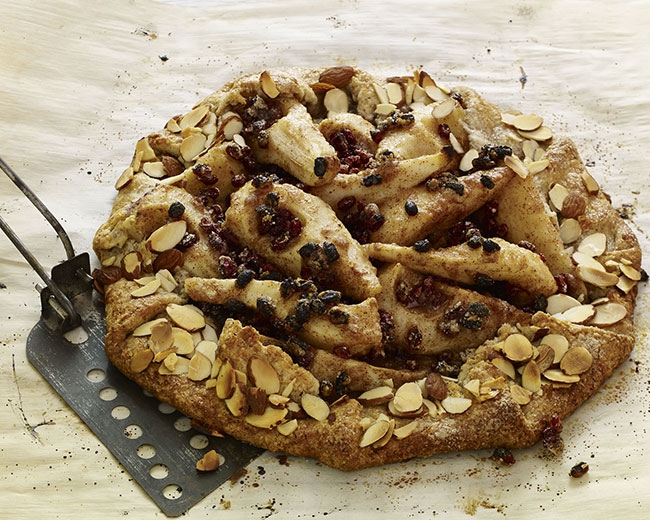
Trending for 2017
February 1, 2017
By
Doug Picklyk
Reviewing industry forecasts and flavour favourites for the year ahead
 developing new products to Photo courtesy of McCormick
developing new products to Photo courtesy of McCormickAs January rolls around there is always a sense of new beginnings and endless possibilities. People resolve to hit the gym and live better lives, and business owners are bursting with excitement about what the new year will bring. For the baking industry, shops set their sights on improving production efficiency and developing new products to appeal to their consumers’ tastes.
To get some indication of what those tastes will be, we’ve scoured the year-end reviews and forecasts for 2017 and distilled some trends that researchers believe will shape the food business for the year ahead.
From a regulatory standpoint, Health Canada introduced its Healthy Eating Strategy last fall, which included a revision of Canada’s Food Guide and is leading to redesigned nutrition facts tables and ingredient lists for packaged foods. The government’s strategy commits to reducing sodium in processed foods, eliminating industrially produced trans-fats and providing consumers with more information about the sugars and food colours in the products they buy.
The government’s steps appear to be in line with consumer trends towards healthy eating and the demand for more clarity about the foods we consume.
Clear label
Globally, Innova Market Insights sees a move beyond clean label ingredient lists to “clear” labels which incorporate the entire holistic supply chain of food products. “Interest in naturalness and clean label continues to feature strongly,” said Lu Ann Williams, director of innovation at Innova Market Insights in a release announcing the research firm’s Top Ten Trends for 2017. “It has become somewhat of a running theme through our trends forecasts in recent years. In 2008, ‘Go Natural’ led our trends list, and since then the theme has featured each year in different forms, such as ‘Processed is Out’ in 2011, ‘From Clean to Clear Label’ in 2015 and ‘Organic Growth for Clear Label’ in 2016. This year, clean and clear is a theme weaving throughout the entire list.”
Topping Innova’s trend list is what it calls “Clean Supreme,” where the growth for clean supply chain claims including “environmentally friendly,” which has shown a compound annual growth rate of 72 per cent between 2011 and 2015, and “animal welfare” claims, which have grown at 45 per cent per year during the same period.
Disruptive Green is another strong trend identified by Innova, as plant-based milks, meat alternatives and vegan offerings rapidly move into the mainstream. “Consumers are looking for innovative options to take the inherent benefits of plants into their daily lives.”
Research firm Mintel also sees a growing interest in vegetarian and vegan products, citing a 25 per cent increase in vegetarian claims and a 257 per cent rise in vegan claims in global food and drink launches over the past five years. This includes vegetarian and vegan claims appearing on products that have always been vegetarian or vegan, but they are now adding the appeals to trigger that sense of identity with the consumer.
While analyzing the food industry this past year, Havas Canada, a marketing and advertising firm, prepared a study on common food trends and how consumers identify with or relate to the food they eat. As part of the supply chain question, consumers are increasingly encouraged to place importance on the quality and source of their food, but now they are challenged by what to prioritize, should they be buying local or organic?
While recognizing we are what we eat, today’s consumers are also conscious of how what we eat also says something about who we are. Food choices have become statements, an expression of lifestyle, self-affirmation and an individual’s relationship to the environment.
The connected culture has also led to changes in how we share of our food experience, going from word-of-mouth to snap-and-show. Instagram accounts dedicated to #foodporn have connected consumers–especially millennials, many of whom consider themselves foodies—to place pressure on food makers to create photo-worthy, socially relevant products.
Back to the relevance of the supply chain story, a Havas global survey notes that fewer than four in 10 respondents said they trust the food industry to provide them with healthful food. When asked to rank six criteria (price, place of origin, nutritional value, ingredients, visual appeal, and brand name) in terms of how important each is in their food-purchasing decisions, brand name came in last. What mattered most were nutritional value and ingredients—people will not assume a product is good for them simply because of the brand name attached to it.
An interesting note, in October 2016 PepsiCo announced its 2025 Sustainability Agenda. The global soft drink maker plans to transform its product portfolio by offering healthier food and beverage choices while also reducing its environmental impact. Its commitment includes having at least two-thirds of its beverages containing 100 calories or fewer from added sugar, per 12-ounce serving, by 2025.
Closer to home
The top projections in foodservice industry research firm Technomic’s 2017 Canadian Trends Forecast see consumers seeking out healthy options but with a balance of unique and familiar flavours. “Canadian consumers want creative, innovative menu items, and we see both restaurant and non-commercial foodservice operators stepping up to the challenge,” said Erik Thoresen, principal at Technomic Inc.
The forecast sees ethnic influences continuing to turn mainstream with South Asian, Middle Eastern and Persian ingredients gaining favour. Even coffee tastes will continue to evolve. Technomic points to lemon coffees, coffee jelly, Indonesian avocado espressos, coffee with butter or salt (or both), and intricate and customizable latte foam art.
Foodservice operators will also be engaging more with Gen Z, the next maturing cohort of ethnically diverse digital natives accustomed to constant convenience, social sharing and a fast-changing world. This demographic also favours a greater emphasis on corporate responsibility and environmental stewardship.
Comfort food
With international instances of political upheaval in 2016—think Brexit and Donald Trump—trend reports foresee people seeking the familiar because
it feels safe. Havas says watch for nostalgia as one antidote to fear as people long for a return to more harmonious times.
Mintel’s Global Food and Drink Trends 2017 echoed the continuing demand for healthy, convenient and trustworthy, noting that people are seeking the “safety of products that are recognizable rather than revolutionary.”
Mintel’s report also suggests that food makers should be looking to the past when seeking innovations for today. “Food and drink with authentic connections to history or tradition provide an inherent element of trustworthiness that many consumers yearn for in a tumultuous world.” This comforting trend lends to the continuing appeal of craft, artisan and handmade food claims. In the bakery, products like ancient grains and promoting ancestral recipes will continue to sell comfort.
A real millennial attraction, but it also applies to all ages, is having a story to tell about food products, building that trustworthiness and authenticity of the products. Mintel research reveals 39 per cent of Canadian adults agree that fusion dishes that combine two or more different types of ethnic items or ingredients are authentic. This opens the opportunity to innovate with authentic tastes.
Food Waste Reduction
Eliminating food waste is also on the minds of consumers. According to the Food and Agricultural Organization of the United Nations, roughly one third, or approximately 1.3 billion tonnes, of the food produced for global human consumption is lost or wasted. Packaging can make a difference when it comes to food waste. Mintel research finds that 56 per cent of U.K. adults would be interested in bread or baked goods with packaging that keeps products fresher for longer.
Time Crunch
According to Mintel, in the U.S., 56 per cent of women and 46 per cent of men say stress is a health issue that concerns them, making it one of the leading health concerns. The complications of life under pressure have led to resurgence in food and drink that leverage the desire for comfort and convenience.
The pace of modern life has fuelled the growth of snacking and on-the-go products. According to Mintel, the number of global food and drink launches with on-the-go claims increased 54 per cent in the five years between 2011 and 2016. The company also reports that 30 per cent of Canadian breakfast eaters say that breakfast products that require little or no preparation are important to them.
Flavour Trends
When it comes to what flavours are leading the way in 2017, Toronto-based THP delivered its second Flavour and Trend Forecast. While last year may have been the International Year of the Pulse and protein-packed baked goods with pulse flours made inroads in the market, THP believes “Fat is Back.”
Forget fat-free labels, THP says butter usage is on the rise, and actually increased by 8 per cent in 2015 compared to 2014. “There’s a shift back to fuller, richer foods–think full-fat dairy, butter and ghee–influenced by a more conscious consumer who is looking to include less processed and more clean, natural ingredients into their diet,” said Sabrina Falone, director of culinary innovation at THP.
The company is also seeing black as the new black. “Activated charcoal is a new ingredient that’s popping up everywhere, from your morning juice routine to your burger bun, and even in your pizza crust,” said Falone. “Don’t shy away from dark-hued foods
next year.”
Globally, McCormick’s Flavour Forecast 2017 includes flavour tends that will entice chefs to explore international tastes:
- Spice up your breakfast options with global flavours. For example, a Middle Eastern-inspired breakfast hash (seasoned chick peas, lamb or beef and roasted vegetables) topped with a skhug sauce (a hot sauce is made with chillies, cumin, cardamom, coriander, garlic, parsley, cilantro, olive oil and lemon juice).
- Espelette pepper, originating from the Basque region of France, delivers a distinctively smoky, sweet and mildly hot flavour to grilled foods.
- Egg yolks leave breakfast behind. Whether poached, fried or cured, chefs are pairing yolks with a range of spices, herbs and sauces on lunch and dinner menus.
- Modern Med–melding Eastern Mediterranean ingredients with Western European classics.
- Sweet on Pepper–the new sweet heat. With an up-front bite and lingering sensation, peppercorns with their cedar and citrus notes pair perfectly with naturally sweet ingredients like dates and dragon fruit.
Consumers find comfort in a bakery, so the challenge for this industry is maintaining well-loved traditional products while mixing in new flavours to keep customers excited. Trends come and go, but keeping your eyes open and taking note of what your customers are asking for is the best solution to keeping up with your own market.
Be bold, and if the trends don’t come to your market, let your shop be the trendsetter.
Print this page


Leave a Reply